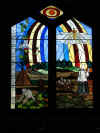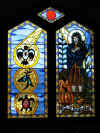![]()
"Polar Bear Express" to Moosonee
On Sunday, we rode the Ontario Northland's Polar Bear Express train for the 180 mile trip to Moosonee (and back). The train runs during the summer months primarily for tourists, stopping only at Moosonee. Year-round there is a companion train, the Little Bear, that makes other stops on the route. These trains are heavily used by the populations of Moosonee and Moose Factory Island - the only other transportation into or out of those areas is by air, which is very expensive in comparison. The train passes through typical Northern muskeg - very similar to what we've seen in the far North of British Columbia.
Once in Moosonee, we boarded a very crowded school bus for a tour of the area. An abandoned Air Force base in town has been converted to housing and a school for the residents. The adjacent Moose Factory Island was the site of a Hudson's Bay Company trading post in the 1800s. There are remnants of the post and quarters, but they're in pretty tough shape. As with other Northern communities, mobility actually increases during the winter months because you can go pretty much anywhere you want by snowmobile, or even cross the frozen-over river to the Island in a passenger car.
We arrived back in Cochrane just before 11PM on Sunday, just in time for a good night's sleep before we set out for an all-day train trip to Toronto on Monday. New York City Tuesday morning after a(nother) night at the Royal York Hotel.
I'm not sure of the ownership of the Ontario Northland Railroad. There is clearly government money supporting this operation, either at a Provincial or Federal level. It provides vital freight and passenger service for many Northern Ontario communities. Ridership was high on both trains we rode, the Polar Bear Express and the Northlander. The cars were comfortable, but extremely noisy. We appreciate the Talgo trains in the Northwest as we ride other equipment!
 |
 |
 |
 |
| Many signs in Cochrane and Moosonee are tri-lingual: English, French, and Cree Indian. This sign was on our hotel room door. | A full-length dome car is part of the Polar Bear Express consist, which included six passenger coaches, two sit-down diners, a cafe car, this dome car, and a bar/gift shop car. | We rolled through mile after mile of uninhabited muskeg. Click here to compare this to what we saw in Northern BC on our trip to Fort Nelson in 2001. | One of the two sit-down diners was also an end-of-train observation car. We enjoyed a good lunch and dinner on board. The wait staff is almost exclusively young persons working summer jobs, and is markedly more personable than the typical passenger train crew. |
 |
 |
 |
 |
| The Ontario Power hydro station at Otter Rapids marks the end of the road for cars - you can drive no further North. Even this remote outpost is no longer manned - it is fully automated and operated from a control center some distance South of here. | The Express crosses the Moose River about 50 miles from Moosonee. | The Moose River trestle, photographed from the end-of-train diner. | Mile after mile of muskeg.... |
 |
 |
 |
 |
| The station at Moosonee proclaims this is the "Gateway to the Artic". | Moose Factory Island is in the distance (more or less). The ferry "Polar Princess" will take us there from Moosonee. | This is Zoe (zo-ee), a Cree Indian with a brand spanking new puppy. | This is the interior of the Anglican church on the Island, which dates to the early 1800s. There was a "tour guide story" that this church had floated some distance off its foundation during a flood. Wooden plugs in the floorboards were rumored to have been put there to keep the church from floating away again. Our guide did offer that there was an alternative, slightly less spectacular, explanation for the wooden plugs - they may have been placed there to provide ventilation. (Natural light photography required me to rest the camera on a pew - I'll straighten it up when I get home.) |
 |
 |
 |
 |
| The Anglican church on Moose Factory Island. | A Cree Indian woman bakes (and sells) bannock bread (with raisins!). | Richard and Carol Pellegrine decided an ice cream bar from the supply store was better than bannock on this very warm day. | The bannock baking teepee, along with a bunch of our group waiting to reboard our (very cramped) school bus we're using for our tour. |
 |
 |
 |
 |
| The Hudson Bay factor (boss) lived on the Island, which is why it's known as Moose Factory Island - not because they make moose here. This is a grave marker for Alexander McDonald, an HBC factor. Note the peculiar wording on the marker: "Sown in corruption, raised in glory" | Mo examines the marker for the factor. | A 50-some bed hospital on the Island uses a central steam plant to heat the entire campus, which includes the hospital, support buildings and housing for the staff. Because of the severe winters, and near permafrost ground conditions, the steam and other utilities are run overhead where they're easier to maintain. | Communities further North on James Bay depend upon barges loaded from boxcars for all their supplies. Anything North of here is accessible by water or boat only. It is possible to drive further North in the winter, and we saw pieces of "tractor trains", which are truck trailers equipped with skis instead of wheels. Several of these are lashed together and towed over the frozen muskeg with a dozer. |
 |
 |
 |
 |
| At Christ the King (Catholic) Cathedral in Moosonee, there is a set of moose antlers behind the altar. | Beautiful new (1987) stained glass panels decorate the church. | This parish covers the largest geographic area, but serves the smallest number of people. We're not sure of how global those comparisons are, but this must surely be true within Ontario at least. | A panel with an image of a Moose appears just above the Cathedral entrance. |
 |
 |
||
| Our train is parked at the Moosonee station while we explore. The streets in town are very dusty. Moosonee has a population of about 3,000, while Moose Factory Island has another 3,500 or so. The population is largely Cree Indian. | On Monday morning, our train bound for Toronto pulls into the station about 7:45 AM. This view is taken from our hotel room window. We'll just walk downstairs and hop on board! |